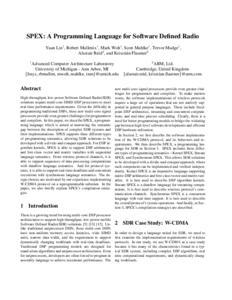SPEX - A programming language for software defined radio
ARM Ltd and University of Michigan
[pdf]
Software Defined Radio Technical Conference and Product Exposition
Orlando, FL, USA
November 2006
Abstract
High-throughput, low-power Software Defined Radio(SDR)
solutions require multi-core SIMD DSP processors to meet
real-time performance requirements. Given the difficulty in
programming traditional DSPs, these new multi-core signal
processors provide even greater challenges for programmers and
compilers. In this paper, we describe SPEX, a programming
language which is aimed at narrowing the semantic gap between
the description of complex SDR systems and their
implementations. SPEX supports three different types of
programming semantics, allowing SDR solutions to be developed
with a divide-and-conquer approach. For DSP algorithm
kernels, SPEX is able to support DSP arithmetics and
first-class vector and matrix variables with sequential
language semantics. From wireless protocol channels, it is able
to support sequences of data-processing computations with
dataflow language semantics. And for protocol systems, it is
able to support real-time deadlines and concurrent executions
with synchronous language semantics. The design choices are
motivated by our experience implementing W-CDMA protocol on
a reprogrammable substrate. In the paper, we also briefly
explain SPEX’s compilation strategies.

BibTeX
@inproceedings{conf:SDR:LinMW2006
, abstract = {
High-throughput, low-power Software Defined Radio(SDR)
solutions require multi-core SIMD DSP processors to meet
real-time performance requirements. Given the difficulty in
programming traditional DSPs, these new multi-core signal
processors provide even greater challenges for programmers and
compilers. In this paper, we describe SPEX, a programming
language which is aimed at narrowing the semantic gap between
the description of complex SDR systems and their
implementations. SPEX supports three different types of
programming semantics, allowing SDR solutions to be developed
with a divide-and-conquer approach. For DSP algorithm
kernels, SPEX is able to support DSP arithmetics and
first-class vector and matrix variables with sequential
language semantics. From wireless protocol channels, it is able
to support sequences of data-processing computations with
dataflow language semantics. And for protocol systems, it is
able to support real-time deadlines and concurrent executions
with synchronous language semantics. The design choices are
motivated by our experience implementing W-CDMA protocol on
a reprogrammable substrate. In the paper, we also briefly
explain SPEX's compilation strategies.
}
, affiliation = {ARM Ltd and University of Michigan}
, ar_file = {SDR_06}
, ar_shortname = {SDR 06}
, authors = {Yuan Lin and Robert Mullenix and Mark Woh and Scott Mahlke
and Trevor Mudge Alastair Reid and Kriszti{\'a}n Flautner}
, booktitle = {Software Defined Radio Technical Conference and Product Exposition}
, day = {13-17}
, file = {lin-sdr06.pdf}
, location = {Orlando, FL, USA}
, month = {November}
, png = {lin-sdr06.png}
, title = {S{P}EX: {A} programming language for software defined radio}
, year = {2006}
}
